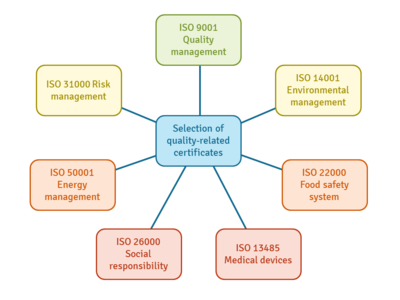Certificate of quality
| Certificate of quality |
|---|
| See also |
Certificate of quality - is also called product certification, product qualification. This is a process when certain product has reached certificate. After product has passed performance tests and quality assurance tests and also meets qualification criteria which are counted in contracts, specifications and regulation[1].
Process of product certification
First of all it must be said that product might be verified to comply with a specification or can be stamped with a specification number. It is not obvious that the product is fit to any particular use. There is group of person or person, who can own the certification process - e.g. engineers, building code writers, government, trade unions. They have the responsibility to choose available specifications, chose the correct ones, enforce complaince, set qualification limits. At the end, there are users who are responsible for life cycle of the product. Moreover, if the product is to work to well, it must be used in accordance with the list of certificate[2].
It is often required to use product certification. Especially in sensitive industry and marketplace areas, where a mistake or failure can have serious consequence. For example, bad effect on health or can hurt people who are using that product. Process of certification products is described in four steps:
- application - includes test of the products,
- aveluation - checked if the test data indicate the products achieve qualification criteria,
- decision - on this stage, is necessary to checked if product application concur with the second step, evaluation,
- surveillance - after certification, at this stage we must cheked if the product in the marketplace continue to meet qualification criteria.
Firstly, a product supplier will send a concrete product to the laboratory, where will be testes. Then, product will be testing in accordance with the labaratory's internal procedures. Results of test are collected and then send to the product certification. Sometimes products required periodic recertification. Certification bodies can require products suppliers to make some sort of surveillance activity. Additionally, there are often some surprise audits of the manufacturing plant. There are also other couses of the recertification, such like: complaints issued to product's functionality[3]. Most product are certified in certification bodies. They are accredited to ISO 17065. This is conformity assessment, international standard for ensuring competence[4].
Examples of certification scheme
We can name several types of certification schemes[5]:
- FCC - Federal Communications Commission,
- TCB - Telecommunication Certification Body,
- IEECE CB Scheme - The International Commission on the Rules for the Approval Of Electrical Equipment Product Safety Certification Body Scheme,
- MAS - Materials Analytical Serices,
- and many more.
Where we need to use certification of quality
There are few axamples that are often required to have product certification[6]:
- aerospace applications,
- food,
- pharmaceuticals,
- healtrcare products,
- dangerous good,
- computers and mobile phones,
- and many more.
Certification mark
A certification mark/label is a type of trademark that is used to show consumers that particular goods or services, or their providers, have met certain standards. Certification marks are names, symbols, or devices used by groups or persons that show compliance to a set of standards. These marks can show geographic origin, standards met with respect to quality or manufacture, or work performed by a person that meets certain standards. It is important, because for product's businessess owners. They want to demonstrate the quality of their products. On the other side, consumers, want to see thath the pruducts that their using, meet desired standards. What is include in certified goods[7]:
- safety,
- morality,
- quality,
- materials used,
- accuracy.
Footnotes
- ↑ Consumer evaluations of product certification 2003
- ↑ Process and product certification arguments: getting the balance right 2006
- ↑ Process and product certification arguments: getting the balance right 2006
- ↑ ISO/IEC Guide 65:1996 2019
- ↑ ISO/IEC Guide 28:2004 2019
- ↑ Process and product certification arguments: getting the balance right 2006
- ↑ Product certification and ecolabelling 2001
References
- Dimaria E., (2003)., Consumer evaluations of product certification, geographic association and traceability in Greece, European Journal of Marketing, Vol. 37 Issue: 5/6
- Habli I., Kelly T.,(2006)., Process and product certification arguments: getting the balance right, New York, Volume 3 Issue 4
- Heck P., Klabbers M., Eekelen M., (2009)., A software product certification model, Software Quality Journal
- House S., (2018)., How consumers respond to product certification and the value of energy information
- Klochkov Y., Odinokov S., Klochkova E., Ostapenko M., (2016)., Development of certification model, India
- Wessells C., Cochcrane K., Deere C., Wallis P., (2001)., Product certification and ecolabelling for fisheries sustainability, Food and Agriculture Organization of the United Nations, Rome
Author: Aleksandra Malczyk
